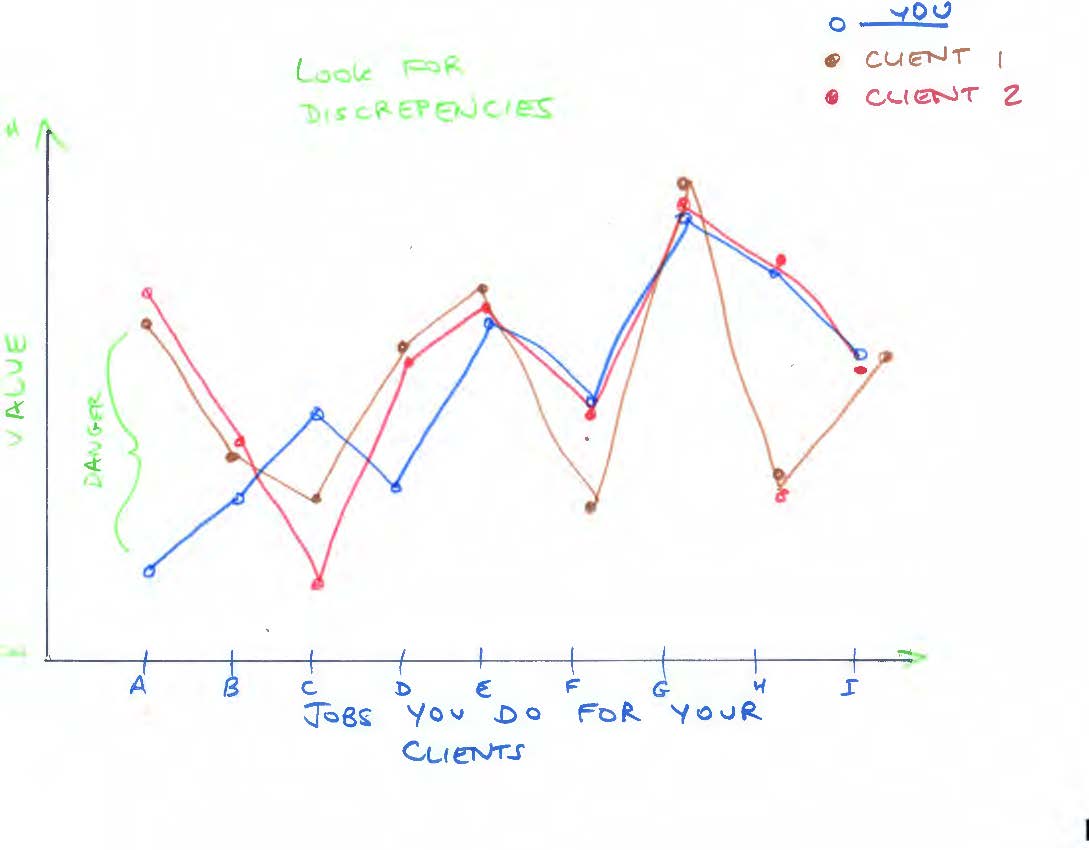When working with clients we stress that value is in the eye of the beholder.
Meaning that what you think is important and what your customer thinks is important are often not the same.
Your customers buy from you to solve an issue. Put another way they have certain jobs to be done and you provide a mechanism to do this.
The graph below charts the jobs you do for your clients versus the perceived value both you and they place on them. We call it a Value Gap Analysis™ (VGA)

You would hope that relative value would be aligned most of the time. But what if they’re not?
What if you think something’s important and they couldn’t care less?
Or they highly value some part of your offering and you had no idea and therefore didn’t give it any attention?
Let’s take these in turn.
Your perception: High Value. Their perception: Low Value – Waste!
We all have finite time, money and effort capability.
You’ll waste a lot of time and resources focusing and delivering things that are not important to your customers at the expense of what aspects are.
Highlighting these aspects in your marketing would be a total waste. They wouldn’t get your clients to raise their hands and want to know more.
Your perception: Low Value. Their perception: High Value – DANGER!
This is a dangerous place to be. You’re not likely to be meeting their criteria for what constitutes a great job. And you risk not delivering what they consider to be important.
And your marketing and sales efforts once again are focused on the wrong areas, rather than on what’s important to them.
All of which begs the question, how do you find the truth.
You ask them!
Make a list of everything you do for your clients. Then break this down into small granular chunks. Each item represents on job your clients want done.
Then ask what value they put on each. Use a scale of 1 to 10 so you get consistency over a number of clients.
In our experience over hundreds of interviews, you’ll start to notice a pattern after about 3 to 6 clients.
Obviously the more you do the better, but there will be a point of diminishing returns.
If your product or service is used by or affects different levels in the organisation – for example top management as well as IT and users, make sure you ask each segment. The relative values will be different.
Your next stage is to plot these into the chart and look for patterns.
Once you confirm what’s truly important for each type of user, you can make decisions as to how you’ll make sure that’s delivered.
You’ll also have directly actionable input for your marketing and sales efforts as you’ll only need to highlight these aspects rather than boring your prospects with stuff that isn’t relevant to them.
Case in point is a member of a mastermind we’re running in Sydney. They’re a medium sized consultancy which specialises in a very narrow software niche. After surveying their clients one thing stood out above all. Their clients LOVED the fact their thinking was CHALLENGED by this supplier. Being asked for why they wanted to do certain things and challenged to look at different perspectives.
Ironically, our mastermind member had felt uncomfortable doing so and usually avoided questioning assumptions.
Now that they know their clients really want this and appreciate this aspect, they’ll be highlighting this in all their marketing and sales material.
Two extra things. When asking your clients about the various items, make sure you ask a final question along the lines of “are there things you’d love us to do that we’re not doing now?”
And think about what your customers are trying to achieve and ask yourself what else they might need surrounding this – stuff that you could supply. Either yourself or through a JV partnership.
Finally, if you’d like a blank copy of the Value Gap Analysis chart you can fill in drop me a note.
